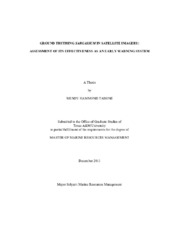| dc.description.abstract | Large aggregations of Sargassum, when at sea, provide important habitat for numerous marine species of vertebrates and invertebrates. It is especially important for the young of several species of sea turtles. However, when large aggregations of Sargassum come ashore on beaches frequented by tourist it is often viewed as a nuisance or even a health hazard. It then becomes a burden to beach management and has to be physically removed as quickly as possible. Many Gulf coast beaches suffer from Sargassum accumulation on a regular basis. Timely information on the size and location of the Sargassum habitat is important to developing coastal management plans. Yet, little is known about the spatial and temporal distribution of Sargassum in the Gulf of Mexico. There is no systematic program to assess the distribution of the macroalgae, therefore practical management plans are difficult to execute.
In 2008, Gower and King of the Canadian Institute of Ocean Sciences along with Hu of the University of South Florida, using satellite imagery, identified extensive areas of Sargassum in the western Gulf of Mexico. These were not confirmed with ground truthing data. To date ground truthing observations have not been directly compared with the corresponding satellite images to confirm that it was in fact Sargassum, as the satellite images suggested.
y building on the information and research methods of Gower and King, current ground truthing data taken from Texas Parks and Wildlife Gulf trawl sampling surveys was analyzed. In addition, shoreline information and imagery was used to substantiate the data derived from current Moderate-resolution Imaging Spectroradiometer (MODIS) Enhanced Floating Algae Index (EFAI) images. As part of the NASA sponsored research project Mapping and Forecasting of Pelagic Sargassum Drift Habitat in the Gulf of Mexico and South Atlantic Bight for Decision Support, NASA satellite MODIS EFAI images provided by Dr. Hu were used to identify and substantiate corresponding floating Sargassum patches in the Gulf of Mexico.
Using the most recent advances in technology and NASA satellite remote sensing, knowledge can be obtained that will aid future decision making for addressing Sargassum in the Gulf of Mexico by substantiating the data provided by satellite imagery. Findings from this research may be useful in developing an early warning system that will allow beach managers to respond in a timely manner to Sargassum events. | en |


